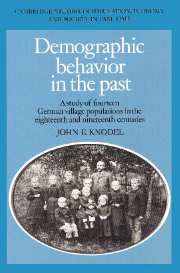 Demographic Behavior in the Past
Demographic Behavior in the Past Book contents
- Frontmatter
- Contents
- List of tables
- List of figures
- Acknowledgements
- PART I INTRODUCTION
- PART II MORTALITY
- PART III FAMILY FORMATION
- PART IV MARITAL REPRODUCTION
- PART V INTERRELATIONSHIPS IN DEMOGRAPHIC BEHAVIOR
- PART VI CONCLUSION
- Appendices
- A Selection of couples for analysis
- B Assessment of the quality of demographic data contained in German village genealogies
- C Local village conditions
- D The occupational and status classification schemes
- E Calculation of infant and child mortality risks
- F Prevailing infant-feeding patterns
- G Evidence of biases in the determination of legitimization status
- Bibliography
- Index
D - The occupational and status classification schemes
Published online by Cambridge University Press: 04 August 2010
- Frontmatter
- Contents
- List of tables
- List of figures
- Acknowledgements
- PART I INTRODUCTION
- PART II MORTALITY
- PART III FAMILY FORMATION
- PART IV MARITAL REPRODUCTION
- PART V INTERRELATIONSHIPS IN DEMOGRAPHIC BEHAVIOR
- PART VI CONCLUSION
- Appendices
- A Selection of couples for analysis
- B Assessment of the quality of demographic data contained in German village genealogies
- C Local village conditions
- D The occupational and status classification schemes
- E Calculation of infant and child mortality risks
- F Prevailing infant-feeding patterns
- G Evidence of biases in the determination of legitimization status
- Bibliography
- Index
Summary
While the reconstituted family histories contained in the village genealogies are rich in information documenting demographic behavior, only limited information is typically available to indicate the social or economic standing of the couple in the community. Such information is usually limited to the mention of the husband's occupation. For some families even this information is lacking. Occasionally there is mention of the husband's legal status in the community, some honorary position, or position in the village leadership, but such information is far less common than occupational designations. No similar information is provided for the wife. In some cases the occupation, legal status, or honorary position of the husband's and wife's fathers are available, although less frequently than for the husband himself. In this study, only information on the husband's occupation or related designation and, to a much lesser extent, status as a village leader is used to differentiate socio-economic groups within the villages.
The purpose of this appendix is to describe in some detail the construction of the occupational and village leader classification employed. Note should be taken that the occupational classification used in the present study is a revised version of the scheme used in previous analyses of the sample villages and thus the occupational differentials in demographic behavior differ from those published in earlier articles.
Occupational classification scheme
Constructing meaningful occupational groupings for past populations from the limited information derived from parish registers is an extremely difficult task.
- Type
- Chapter
- Information
- Demographic Behavior in the PastA Study of Fourteen German Village Populations in the Eighteenth and Nineteenth Centuries, pp. 520 - 534Publisher: Cambridge University PressPrint publication year: 1988


